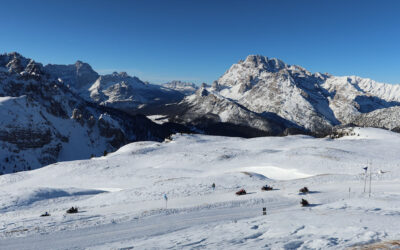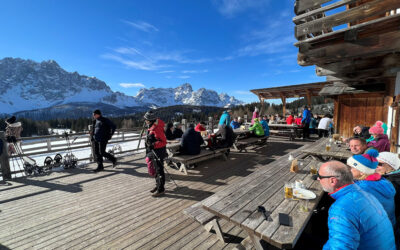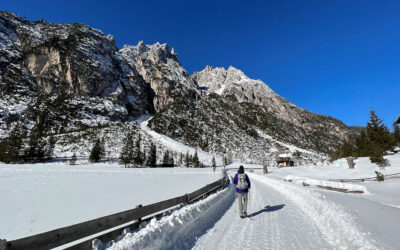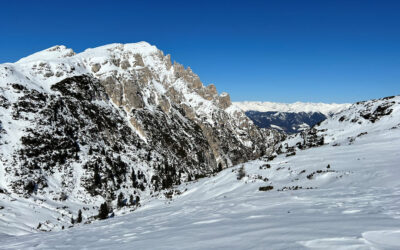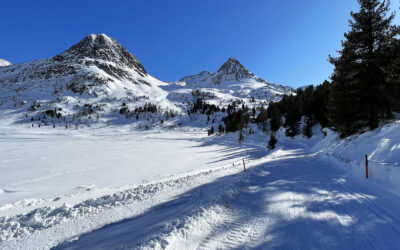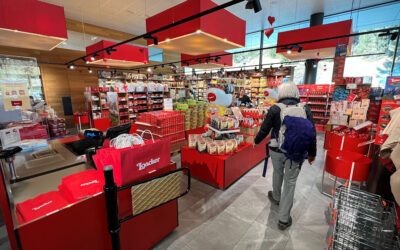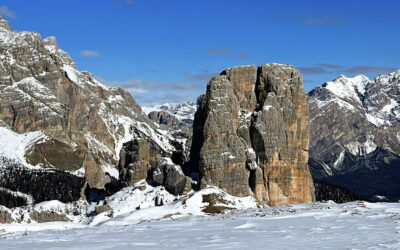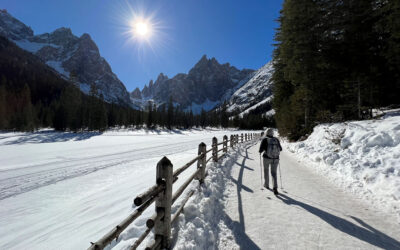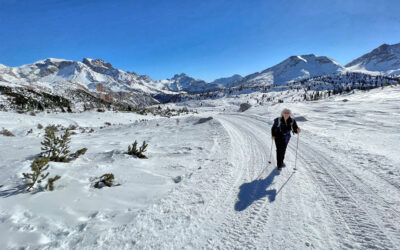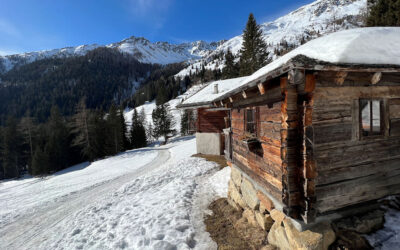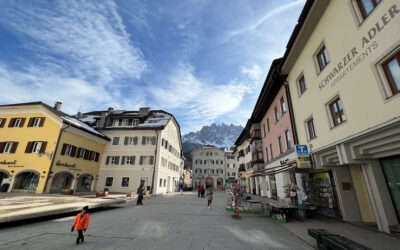Innichen
February 4 - 17, 2023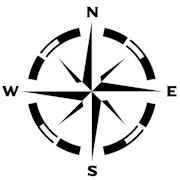
Our Return To Innichen
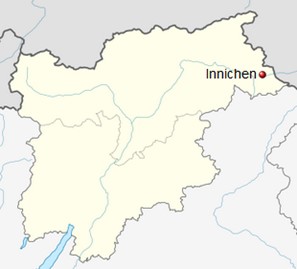 The first stop for this three week winter adventure in the Dolomites was the delightful town of Innichen, also known as San Candido in Italian or Sanciana in the regional Ladin dialect. Innichen lies in a dramatic setting on the floor of the Val Pusteria, which runs eastward from Fortezza all the way to the Austrian border. Innichen is actually located just a few miles from Austria and in pre-EU times was the site of an important border crossing.
The first stop for this three week winter adventure in the Dolomites was the delightful town of Innichen, also known as San Candido in Italian or Sanciana in the regional Ladin dialect. Innichen lies in a dramatic setting on the floor of the Val Pusteria, which runs eastward from Fortezza all the way to the Austrian border. Innichen is actually located just a few miles from Austria and in pre-EU times was the site of an important border crossing.
History runs deep here with the earliest settlements believed to date back as far as 1000 BC. The two main churches are decidedly newer, but even those are impressively old by American standards. The cathedral of San Candido, also referred to as the La Collegiata di San Candido, dates to the middle of the 12th century. Its blockish Romanesque architecture is quite foreboding and is very much in contrast with the dramatic Baroque styling of the Chiesa di San Michele, ca. 1735. San Michele is especially hard to miss with the gold gilt statues on the facade facing the town square. Both churches have stunning (albeit very different) interiors and are well worth a visit.
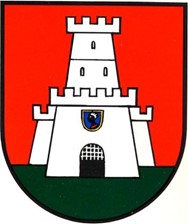 This is not to say that everything in the area is old; in fact Innichen partnered with the neighboring town of Dobbiaco to make a very modern (and award-winning) investment in renewable energy. The two towns are now served by a shared centralized heating plant that burns waste products from the wood and timber industry to generate electricity for the grid as well as steam for use in heating nearby homes and businesses. In a clever twist, even the spent steam is run through heat exchangers to produce domestic hot water.
This is not to say that everything in the area is old; in fact Innichen partnered with the neighboring town of Dobbiaco to make a very modern (and award-winning) investment in renewable energy. The two towns are now served by a shared centralized heating plant that burns waste products from the wood and timber industry to generate electricity for the grid as well as steam for use in heating nearby homes and businesses. In a clever twist, even the spent steam is run through heat exchangers to produce domestic hot water.
As with the rest of Südtirol, this region was actually part of Austria until immediately after World War I when it was granted to Italy as part of Austria’s war reparations. Even a century later the people, language, architecture, and food found here are still very much Germanic – as a matter of fact the 2011 census reported that 85% of the population still spoke German as their first language.
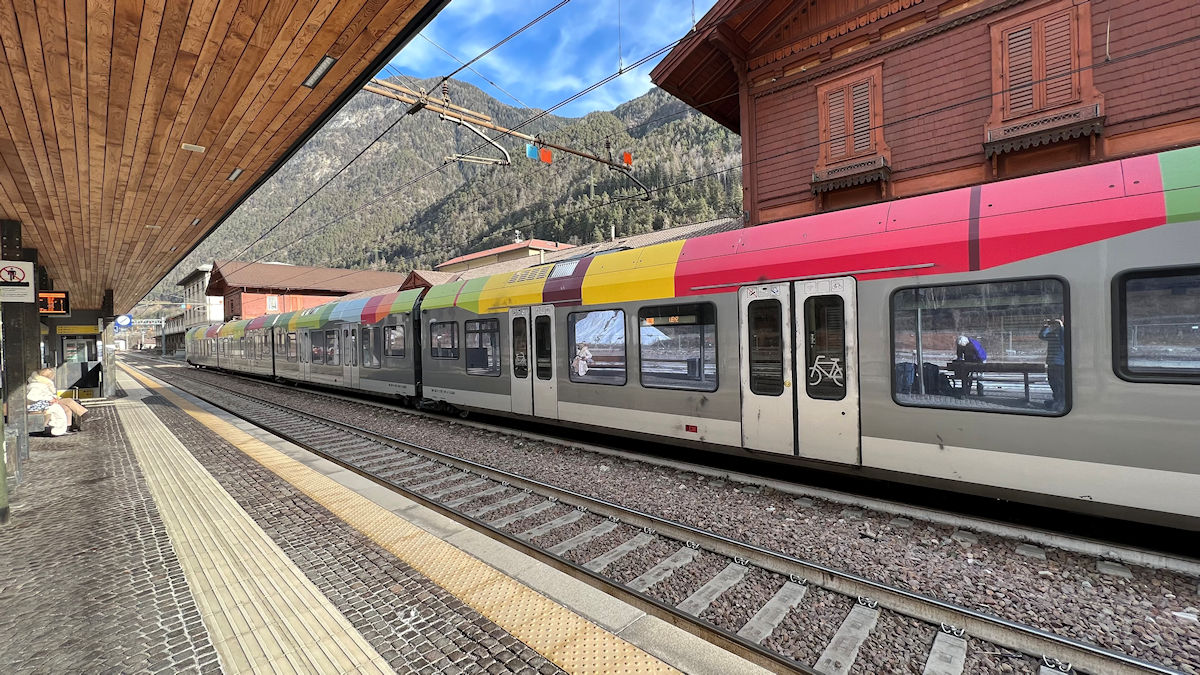 Travel to the relatively remote Südtirol region is reasonably easy with a flight to Atlanta from Richmond, a flight to Munich from Atlanta, and then some combination of trains and buses to reach your final destination – all told it’s usually something over 24 hours from door to door.
Travel to the relatively remote Südtirol region is reasonably easy with a flight to Atlanta from Richmond, a flight to Munich from Atlanta, and then some combination of trains and buses to reach your final destination – all told it’s usually something over 24 hours from door to door.
The majority of this trip went to plan, but we did have a bit of an unexpected adventure on the final leg when our Südtirolmobil train pulled into Bruneck. This was supposed to be just an ordinary stop and the train should have pulled out in a few minutes after unloading and loading passengers. Instead there was an announcement on the intercom (unusual), all of the passenger car doors suddenly opened by themselves (also unusual), and everyone started to get off. A few folks such as ourselves that weren’t locals and didn’t understand the announcement, which was only in Italian, stayed behind and wondered what was happening. A kind soul that happened to speak English stepped back onto our train car and explained that for some unknown reason this was the end of the line and that the train would be returning to Fortezza where we initially boarded.
At this point we joined the crowd inside the Bahnhof trying to figure out what was going on but the customer service window was closed and there were no employees in sight. The language barriers (and admittedly our jet lag) made for a rather confusing situation. An employee finally did arrive and explained that a windstorm had knocked down some large trees onto the power lines that supplied electricity for the track between Bruneck and the Austrian border. Given that bit of bad news we finally decided to try for a taxi. We called several local companies but they were all fully booked, as expected given the circumstances. Cindy then called a company a bit further down the valley and found a taxi that was available to help us. The driver spoke good English and was friendly so the 45 minute ride along the valley floor to Innichen was actually quite interesting.
Innichen was a great location for us given that we relied, as usual, on buses and trains to get around. The town’s Bahnhof gave us regional train access and there were also good bus connections, all just a short walk (about two blocks) from our apartment. Staying in Innichen enabled us to visit nearby favorites such as the iconic Tre Cime di Lavaredo, the beautiful Val Fiscalina, the memorable Innerfeldtal, and the expansive Prato Piazza. We made a return visit to the Cinque Torri, an amazing rock formation near Cortina d’Ampezzo and even spent in the night in a remote mountain lodge called the Berggasthaus Pederü. During this trip we also expanded our horizons towards the northern side of the Pustertal valley with trips to the Antholzer See and Santa Magdalena as well as a quick excursion eastward to Sillian, Austria. Read our blog below for more details about all of these adventures.
This was our second time staying in Innichen and our third visit overall. We had previously scoped out the town in January of 2020 when we spent twelve days just down the road in Dobbiaco. We then spent a full week there during our epic five week “revenge travel” tour of the Dolomites in the fall of 2022. As a result of these prior visits we were confident that Innichen would work well this time around. Innichen met all of our expectations so we hope to return soon!
Our Blog For Innichen
Day 1 – Hiking From Rifugio Auronzo
Cindy and I visited one of the marquee attractions in the Dolomites : the stunning (and snowy!) Tre Cime di Lavaredo.
Day 2 – A Visit To Alpe Nemes Hütte
For today’s adventure Cindy and I hiked from the small town of Moos up to the Nemes Alpe Hütte near Kreuzberg Pass.
Day 3 – Lunch At The Jora Hütte
WIth the weather so cold we decided to make two smaller hikes today – lunch at the Jora Hütte and a hike to Lago di Dobbiaco.
Day 4 – Into The Innerfeldtal
For today’s adventure we explored the Innerfeldtal. We first visited this dramatic canyon during the winter of 2020.
Day 5 – Hiking Prato Piazza
Thursday’s adventure was a return visit to Prato Piazza, a spectacular high altitude plateau buried deep in the Dolomites.
Day 6 – North To The Antholzer See
Today we explored the Antholzertal, a scenic valley that features a beautiful mountain lake called the the Antholzer See.
Day 7 – A Visit To Sillian Austria
Today was Stuart’s birthday. The skies were overcast so it didn’t look like a good day to take a marquee hike.
Day 8 – A Return To Cinque Torri
Today’s adventure was a visit to Cinque Torri, a dramatic rock formation not far from the glitzy ski town of Cortina d’Ampezzo.
Day 9 – Hiking The Val Fiscalina
Today we took a bus ride into the Sextental valley to the town of Moos for a hike into the stunning Naturpark Drei Zinnen.
Day 10 & 11 – The Sennes Hütte Adventure
On Tuesday and Wednesday Cindy and I made an overnight getaway to a small resort accessible from the Val Badia.
Day 12 – Lunch At The Kradorferalm
Today was a quiet and easy day, entirely by design given that Cindy was still recovering from being very sick the day before.
Day 13 – Wandering Innichen
Today we were both tired and Cindy was still under the weather, so we decided to take it easy and wander around Innichen.
Useful Links For Innichen
General Information :: Wikipedia
Weather :: weather.com
Official Website :: Marktgemeinde Innichen
Tourist Office :: Dolomites.org
Travel Planning :: Trip Advisor
Lodging :: Airbnb / VRBO
Train Information :: Bahn.com / Trenitalia.com
Regional Transit Information :: Südtirolmobil

